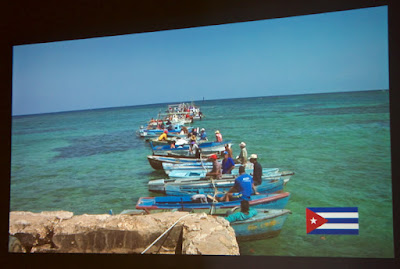You can be forgiven for not having heard of the Belgian-born Mexican artist Francis Alÿs. But for decades he has been creating -- off the radar -- political, conceptual and performance pieces.
John and I recommend his latest exhibition The Story of Negotiation at the Art Gallery of Ontario.
We loved the small paintings in Bridge (2005)
a collection paintings, models, drawings and videos
set at the Straits of Gibraltar
and dealing with issues of immigration in a playful, imaginative way.
Look for this line of boats made of cheap flip-flop shoes.
Around the corner you will see this video featuring a line of Moroccan children carrying the handmade boats into the surf
of the Straight of Gibraltar.
A set of videos observes Europeans looking at the coast of North Africa from Gibraltar
and Moroccans looking toward Gibraltar. Fascinating differences of dress and body-language emerge.
In Don't Cross the Bridge Before You get to the River (2008) we find the artist himself
co-ordinating a piece in which boat owners from Cuba and sailors from Key West, Florida attempt to reach each other across a bridge of boats.
We alternate between Cuban and American boat owners lashing their boats together.
On-screen flags identify the Cuban and American sides.
Don't miss the film Tornado (2000-2010) in which Alÿs locates tornadoes in the post-harvest Mexican corn fields
and runs toward them with his hand-held movie camera.
The results are spine-tingling.
We'll mention one more film -- REEL-UNREEL (2011).
The setting is Kabul, Afghanistan where the Taliban had recently burned a number of films. (Happily they were copies of the originals.)
Young Afghani boys are given films to examine
and then to play with in the streets of Kabul.
Alÿs follows one boy who unwinds a reel of film as he runs.
Another boy runs behind winding the film back on to the reel. The innocent play of the young kids is touching in their war torn country.
We'll leave you to contemplate another pair of videos.
Sometimes Doing is Undoing and Sometimes Undoing is Doing ( 2013) is set in Afghanistan and shows an Ajmal Maiwandi soldier and a UK soldier efficiently cleaning their weapons. They both do it so well the effect is fascinating.
If you can, give yourself an hour or two to appreciate this exhibition. It will be time well spent. The Story of Negotiation continues at the AGO until April 2, 2017.



















































